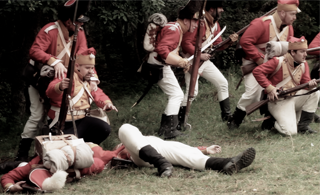The year is 1807. In Fiksdalen, Ola Kvernhusdalen is working his fields. The Napoleonic Wars are ravaging Europe. The Danish-Norwegian Kingdom remains neutral for as long as possible. Following the attack on Copenhagen by the British in August, in what has been known as the great fleet robbery, the Danish Prince Regent Fredrik is forced to choose sides. The Danish-Norwegian Kingdom becomes an ally of Napoleon.
For Norway and Norwegians this has major consequences. A British blockade of Norwegian and Danish ships leads to starvation and famine. Grain imports from Denmark cannot reach their destinations. For some the consequences are more direct. They are drafted. In 1808 Ola is sent off to war. He is one of 30 men from Stjørna participating in the Napoleonic Wars. Most of them fight on the high seas, in the cannon war against the British, but Ola is a soldier in the army and lost many friends in battle. He helps carry the wounded to where they can be cared for. The shirt of a fallen soldier helps protect him from the cold. He’s constantly hungry. Many Norwegian soldiers’ lives are lost in the power struggles on the continent, including many of the men from Stjørna. In 1814 Napoleon is exiled to the island of Elba, and in the Treaty of Kiel the Danish King loses Norway to Sweden. After a month of fighting against the Swedes, the country is once again at peace.
The year is 1914. A hundred years have passed since Ola and the other soldiers from Stjørna could return home to their farms, in a new and free Norway. On a plateau by the fjord on the Refsnes farm, a monument is placed “to commemorate the men from Skjørn who participated in the war”. The monument also commemorates 1814 and the Norwegian Constitution.


One comment
Leave a reply